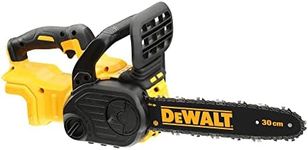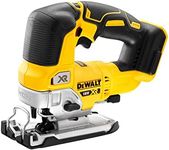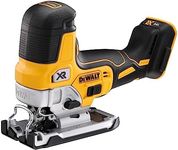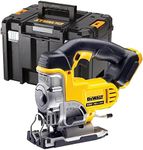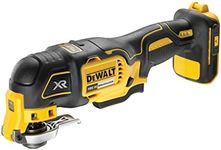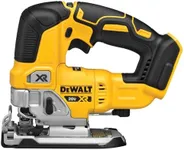Buying Guide for the Best Dewalt Jigsaws
When choosing a jigsaw, it's important to consider the specific tasks you plan to undertake. Jigsaws are versatile tools that can cut through a variety of materials, including wood, metal, and plastic. The right jigsaw for you will depend on the type of projects you are working on, the materials you will be cutting, and your level of experience. Understanding the key specifications will help you make an informed decision and ensure that you select a jigsaw that meets your needs and enhances your work efficiency.Power SourceJigsaws can be powered by either electricity (corded) or batteries (cordless). The power source is important because it affects the tool's portability and runtime. Corded jigsaws offer continuous power and are ideal for long projects where you have access to an electrical outlet. They are generally more powerful and can handle tougher materials. Cordless jigsaws, on the other hand, offer greater mobility and are convenient for working in areas without easy access to power. They are suitable for lighter tasks and quick jobs. Consider where and how you will be using the jigsaw to determine which power source is best for you.
Motor PowerMotor power, measured in amps for corded models and volts for cordless models, determines the cutting capability of the jigsaw. Higher motor power allows the jigsaw to cut through thicker and harder materials with ease. For heavy-duty tasks or frequent use, a jigsaw with higher motor power (around 6-7 amps for corded or 18-20 volts for cordless) is recommended. For lighter tasks or occasional use, a lower power jigsaw (around 4-5 amps or 12-18 volts) may suffice. Assess the types of materials you will be cutting to choose the appropriate motor power.
Variable Speed ControlVariable speed control allows you to adjust the speed of the blade, which is crucial for cutting different materials. This feature is important because different materials require different speeds for optimal cutting. For example, slower speeds are better for metals, while faster speeds are suitable for wood. Jigsaws with variable speed control offer more versatility and precision. If you plan to work with a variety of materials, look for a jigsaw with this feature. If your projects are more uniform, a single-speed jigsaw might be sufficient.
Orbital ActionOrbital action refers to the movement of the blade in a slightly circular motion, in addition to the up-and-down motion. This feature is important because it allows for faster and more aggressive cuts, especially in wood. Jigsaws with adjustable orbital settings provide more control over the cutting action, making them versatile for different tasks. If you need to make quick, rough cuts in wood, a jigsaw with orbital action is beneficial. For more precise or delicate cuts, a jigsaw with minimal or no orbital action might be preferable.
Blade Change SystemThe blade change system determines how easily you can replace the jigsaw blade. This is important for efficiency and safety, especially if you frequently switch between different types of blades for various materials. Tool-less blade change systems are convenient and allow for quick blade swaps without the need for additional tools. If you anticipate changing blades often, look for a jigsaw with a tool-less blade change system. If you rarely change blades, this feature might be less critical.
Bevel CapacityBevel capacity refers to the jigsaw's ability to make angled cuts, typically up to 45 degrees. This feature is important for projects that require angled or beveled cuts, such as in carpentry or decorative work. A jigsaw with adjustable bevel capacity allows for more versatility in your projects. If you plan to make a lot of angled cuts, ensure the jigsaw has a good bevel capacity. If your work is mostly straight cuts, this feature may not be as important.
